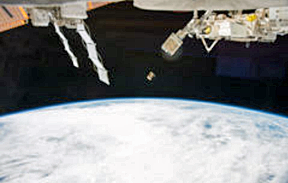 NanoRacks successfully completed the company’s 13th cubesat deployment mission from the International Space Station — as these five cubesats enter LEO, this brings NanoRacks to 176 total smallsats deployed into space via the NanoRacks CubeSat Deployer (NRCSD) — in total, the Company has deployed 193 satellites into space.
NanoRacks successfully completed the company’s 13th cubesat deployment mission from the International Space Station — as these five cubesats enter LEO, this brings NanoRacks to 176 total smallsats deployed into space via the NanoRacks CubeSat Deployer (NRCSD) — in total, the Company has deployed 193 satellites into space.

The first smallsats launched from the ISS via NanoRack's Doublewide Deployers.
Additionally, this mission marks the first deployment of the industry standard 6U cubesats in the 2U x 3U form factor from the NanoRacks ‘Doublewide’ Deployers. The 6U satellites deployed were EcAMSat, Dellingr, and ASTERIA. The NRCSD-13 Mission included satellites launched on the most recent SpaceX and Orbital ATK commercial resupply services missions to station for NASA, which launched August 14 and November 12, 2017, respectively.
NanoRacks External Payloads Manager Conor Brown reported that it’s critical for the company to grow cubesat services with the changing smallsat landscape. Cubesats are following a similar path as cellphones — first they were as small as possible, and now they are starting to grow in both size and capability. Now, beyond just accommodating the industry standard 6U form factors, cubesats can be deployed up to 12U in size from the ISS, providing opportunities for more advanced payload concepts. To speak specifically, the timeline for the EcAMSat biological satellite is unprecedented. From contract signing to in-space deployment, the entire launch campaign required less than seven months, with deployment occurring within one week of arriving at the ISS.
About the launched smallsats...
EcAMSat
EcAMSat is a 6U CubeSat developed by the NASA’s Ames Research Center in Silicon Valley, in partnership with Stanford University School of Medicine. It is the first NASA biology mission in the 6U configuration. EcAMSat will investigate the space microgravity effect on the antibiotic resistance of E. Coli, a bacterial pathogen responsible for urinary tract infections in humans and animals.
Dellingr
Radiation Belt Loss Experiment, also known as Dellingr, is a 6U CubeSat developed by NASA’s Goddard Space Flight Center in Greenbelt, Maryland, and the agency’s Wallops Flight Facility in Wallops Island, Virginia. Dellingr is equipped with an Ion-Neutral Mass Spectrometer and Science Magnetometers intended to increase our understanding of solar wind energy disposition on composition changes in Earth’s upper atmosphere. This understanding of space weather can help protect communication resources and reduce risks associated with electromagnetic exposure. This project also demonstrates CubeSat performance capability for large-scale remote sensing tasks.
TechEdSat-6
Technology Educational Satellite 6, also known as TechEdSat-6 is a 4U CubeSat developed by San Jose State University and the University of Idaho as a collaborative engineering project with oversight from NASA Ames. This satellite will be demonstrating an Exo-Brake system to provide a targeted nanosatellite de-orbit using a fully propellant-less technique. Future spacecraft that may utilize this Exo-Brake system include small payloads returning to Earth or landing on Mars. This satellite is part of the TechEdSat family, of which NanoRacks has deployed several from the ISS!
OSIRIS 3U
Orbital Satellite for Investigating the Response of the Ionosphere to Stimulated Space Weather (OSIRIS-3U) is a 3U CubeSat developed by Pennsylvania State University. It will conduct atmospheric research on the effects of solar flare activity on the Ionosphere. Ground based heaters will stimulate Ionosphere to create artificial space weather events and science instruments on OSIRIS-3U will measure the electron content, density and temperature.
All five of these satellites were selected for flight by NASA’s CubeSat Launch Initiative (CSLI) as a part of the Educational Launch of Nanosatellites (ELaNa) missions, sponsored by the NASA Launch Services Program (LSP).

